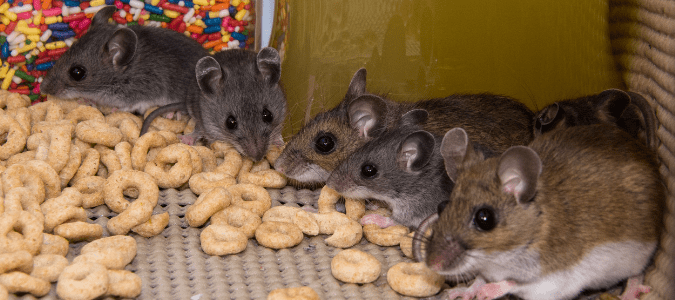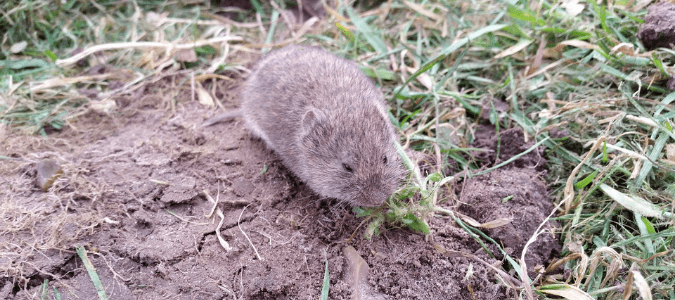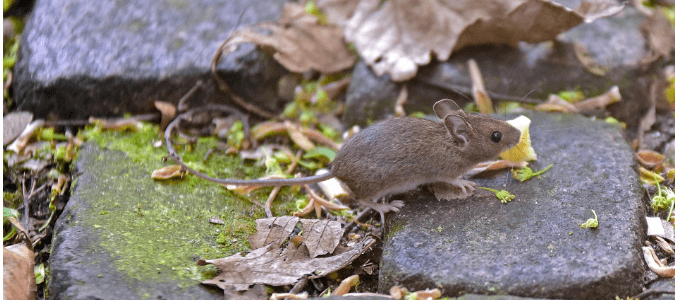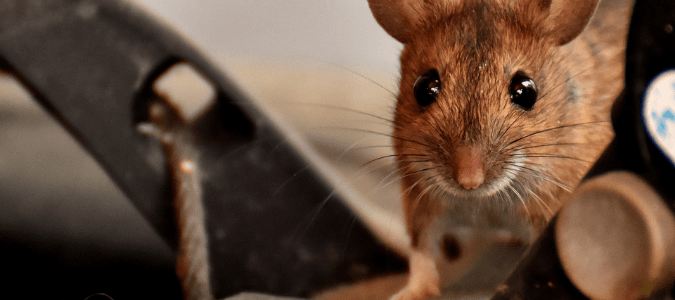If you’ve ever had a mouse problem, you probably wondered what attracted the mice to your house in the first place. What do house mice eat? Their natural habitat is outdoors, so what do they live on when they move into a person’s home? Unfortunately, the short answer is that mice can eat a wide variety of foods. This is why they can live so well inside a house, as long as there is access to water as well as some food that they can get into.
The truth is, most of us have plenty of food that mice could get into if they tried. For example, readily available food left in fruit bowls on our countertops. Or, the thin plastic bags and cardboard boxes filled with cereals and snacks found in our pantries. These materials are easy for mice to chew through to get to the food inside.
Outside in nature, mice eat fruits, seeds and grains. That’s why many homes with fruit-bearing trees in the yard can have mouse problems. These small rodents will nibble on fallen fruit in the yard. From there, it’s usually easy enough to find a way inside the house. Mice can squeeze through tiny spaces—think of a hole that’s smaller than a dime. Even seemingly tiny gaps around doors or windows can give mice a way in.
Once inside a home, a mouse can usually find plenty of things to feed on as well as shelter to hide. In fact, many times people are unaware that they have a mouse problem for a long time.
Signs of a Mouse Infestation
Sometimes, the only signs of a mouse infestation might be small rustling or squeaking noises coming from inside the walls. Another sign of a problem is mouse droppings on top of cabinets or high shelving, or gnaw marks on the baseboards.
Mice eat multiple times a day. If they are spending time in your pantry, snacking on your cereal and grains, they will leave a mess. This is yet another sign that you have a mouse problem. Mice also need to gnaw every day, as they have constantly growing front teeth that need to be filed down through regular gnawing.
This is one of the reasons a mouse infestation can be such a big problem in your home or garage. Mice can chew through electrical wiring, causing a fire hazard. Their chewing through wood and PVC pipes can also cause structural damage.
Even their urine and feces can cause big problems since it can soak through drywall and contaminate large areas. Mouse droppings can even make some people sick by triggering their allergies, and mouse feces can also transmit food-borne illnesses like salmonella.
This is one of the biggest reasons why it’s important to have a professional handle a rodent problem on your property. Pest control professionals have the protective gear and other equipment needed to find a mouse nest and deal with it safely.
Furthermore, mice are incredibly prolific breeders. A female mouse can have 50 to 60 babies in a single year. A mouse infestation can grow well into the thousands if it isn’t found and treated. This is yet another reason why people who try to get rid of mice on their own often find it to be a frustrating undertaking. Additionally, it can end up prolonging the problem and making it worse.
How To Make Your Home Less Attractive to Mice
Fortunately, there are some steps you can take to make your home less friendly to mice:
- Close off rodent access to your home. Look around your house for any holes or gaps around windows and doors; around vents or hose bibs; or in the eaves of your house or garage. Any holes you find should be repaired, caulked, covered with wire mesh or stuffed with steel wool. This will help keep out other pests, as well.
- Keep your yard mowed and your landscaping trimmed. If you have fruit bushes or trees, clear away the fallen fruit so mice won’t be drawn to your yard.
- Inside your home, repair any leaky faucets or pipes so mice can’t use these as a steady water supply.
- In the kitchen and pantry, store all foods in airtight containers made of glass or thick plastic that mice can’t easily chew through. Don’t keep fruits or other foods out on the counters.
- Store pet food in well-sealed containers, too. Additionally, don’t leave your pets’ food and water bowls out overnight, as these can draw mice as well as other pests.
- If you decide to set out bait traps to catch mice, be sure to set them out in areas where pets and children won’t accidentally encounter them. Also, set them against the wall rather than out in the middle of an open space, because mice don’t tend to run out in the open. Rather, they run along walls or rafters, using the same trusted routes again and again. Additionally, be sure to research the best foods to put in a mouse trap.
Unfortunately, even following all the steps above may not control the problem if you have an established mouse population. This is why many homeowners choose to reach out to a pest control specialist. Specialists can inspect your home for any signs of mouse activity and recommend the best treatment plan to control your rodent problem.
Field Mouse Versus House Mouse: How to Identify Which One You’re Dealing With
If you see a mouse out in your yard or inside your home, you might wonder if it is a field mouse or a house mouse. Are they really, in fact, the same type of mouse—just one lives outdoors and the other inside? How can you figure out which rodent you’ve seen and what should you do about it?
Field Mice
Many people don’t realize that the term “field mouse” is an umbrella term that describes many different types of mice. Most commonly, however, it’s used to refer to meadow mice. As you can see in the image above, these creatures are a little bigger than house mice, but they’re still smaller than rats. Their fur is coarse and usually a dark gray or grayish-brown color. Their legs and tails are usually a little on the shorter side, and their ears are also smaller than those of some types of mice, and lie closer to the head.
Voles live in grassy areas with soil that they can burrow into. This might be a field, a pasture or even a grassy ditch. They often make burrows near fruit trees and can do a lot of damage since they eat the fruit and bark. They also feed on the trees’ root crowns and have even been known to chew through irrigation lines that have been set up to water the trees. If you’ve noticed an animal is digging up your lawn, it could be a meadow mouse or even a group of meadow mice.
True field mice, meaning those living in pastures and orchards, don’t typically make their way into homes. Generally, they aren’t close enough to people’s homes to infest a house or become a problem indoors.
House Mice
Along with voles, house mice actually fall under the “field mice” umbrella as well. House mice can get indoors in a variety of ways, but they most often come in through surprisingly tiny holes in the roof or eaves, or around a door, window or exterior vent. House mice also slip inside through doors and windows that have been left open. Inside, they can cause lots of damage because of their need to gnaw, their ability to breed so quickly, and the fact that they can carry bacteria and diseases that can make people sick.
As you can see in the image above, house mice look different from field mice in several ways. They are a bit smaller, with larger eyes and ears and longer tails. Their fur may be a bit lighter in color and softer in texture. If you have mice living inside your home, chances are good that they are common house mice. A licensed pest control professional can investigate your home to determine where the mice are most active. Then, they can create a plan to control these rodents.
Do House Mice Carry Diseases?
Seeing a mouse inside the home can be shocking, and not just because of the ick factor. If you see one inside your home, you might wonder: Do house mice carry diseases? Unfortunately, they do carry diseases and can cause illnesses in humans. Additionally, their feces, urine and saliva can contaminate the areas they touch, which can make people sick.
Mice are known to carry over 35 different diseases that can affect humans. These include hantavirus and plague. People who come into contact with mouse droppings and urine can also contract salmonella and leptospirosis. Mouse droppings have even been known to cause respiratory allergies in some people.
In addition, mice can carry fleas and ticks into a home with them, which can result in secondary pest infestations. Unfortunately, these pests are also capable of transmitting diseases to us and our pets.
Handling mice, their droppings or the materials they use to build nests can bring you into contact with dangerous bacteria and contaminants. This is yet another reason a mouse infestation is a problem best left to a professional. A professional has the protective gear along with the best products, knowledge and techniques needed to get rid of rodents.
ABC Can Identify and Control the Mice on Your Property
Dealing with a mouse infestation can be exhausting. Instead of spending your free time attempting do-it-yourself control methods, contact ABC Home & Commercial Services. Our specialists are highly trained and will create a rodent control plan that best fits your needs. This way, you and your family members can feel comfortable at home again.




